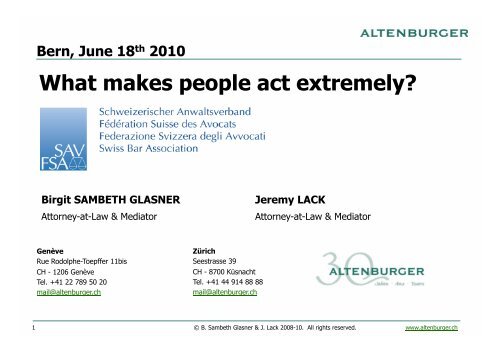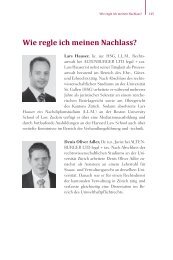B. Sambeth & J. Lack -- What makes people act extremely (Bern ...
B. Sambeth & J. Lack -- What makes people act extremely (Bern ...
B. Sambeth & J. Lack -- What makes people act extremely (Bern ...
Create successful ePaper yourself
Turn your PDF publications into a flip-book with our unique Google optimized e-Paper software.
<strong>Bern</strong>, June 18 th 2010<br />
<strong>What</strong> <strong>makes</strong> <strong>people</strong> <strong>act</strong> <strong>extremely</strong>?<br />
Birgit SAMBETH GLASNER Jeremy LACK<br />
Attorney-at-Law & Mediator Attorney-at-Law & Mediator<br />
Genève<br />
Rue Rodolphe-Toepffer 11bis<br />
CH - 1206 Genève<br />
Tel. +41 22 789 50 20<br />
mail@altenburger.ch<br />
Zürich<br />
Seestrasse 39<br />
CH - 8700 Küsnacht<br />
Tel. +41 44 914 88 88<br />
mail@altenburger.ch<br />
1 © B. <strong>Sambeth</strong> Glasner & J. <strong>Lack</strong> 2008-10. All rights reserved. www.altenburger.ch
Conflict Escalation Theory: Glasl’s 9 Steps<br />
1<br />
Disagreement<br />
The Problem<br />
2 Debate+polemic<br />
The <strong>people</strong><br />
3 Actions,<br />
not words<br />
WIN-WIN 4 Images and<br />
coalitions<br />
5 Deliberate loss<br />
of face<br />
6 Management of<br />
threat<br />
WIN-LOSE 7 Limited destructive<br />
blows<br />
8 Fragmentation<br />
of the enemy<br />
Inspired by: Tina Monberg<br />
F. Glasl’s “Confronting Conflict”<br />
Target zone for conflict resolution<br />
LOSE-LOSE<br />
The “extreme” zone?<br />
Together into<br />
the abyss<br />
2 © B. <strong>Sambeth</strong> Glasner & J. <strong>Lack</strong> 2008-10. All rights reserved. www.altenburger.ch<br />
9
The Outcome: A “Triune Brain” = 3 Phases of Evolution<br />
See : Paul D. MacLean http://en.wikipedia.org/wiki/Triune_brain<br />
Source:<br />
http://www.solarnavigator.net/biology/<br />
biology_images/brain_animal_comparisons.jpg<br />
Level 3. The<br />
Neocortex:<br />
High-order<br />
thinking &<br />
cognition<br />
Level 1. The<br />
Reptilian Brain:<br />
Survival<br />
Level 2. The<br />
Limbic System:<br />
Emotions<br />
Source: http://www.cop.com/info/346edb.gif<br />
3 © B. <strong>Sambeth</strong> Glasner & J. <strong>Lack</strong> 2008-10. All rights reserved. www.altenburger.ch
Danger is more dominant than Reward<br />
Threat/<br />
Pain<br />
(“away”<br />
mode)<br />
The Mediator’s Challenge:<br />
How to systematically minimize perception of danger &<br />
maximize perception of reward during mediation?<br />
•� Faster <strong>act</strong>ing<br />
•� Stronger<br />
•� Longer lasting<br />
•� Adversarial capacities up<br />
•� Cognitive capacities slowed<br />
down<br />
•� More likely<br />
Source: F. Bogazc, from Dr Dan Radecki – Neuroleadership Institute<br />
Reward<br />
(“towards”<br />
mode)<br />
•� Slower <strong>act</strong>ing<br />
•� Milder<br />
•� Shorter<br />
•� Cognitive capacities up (i.e.,<br />
pre-frontal cortex decision<br />
making)<br />
•� Less likely<br />
4 © B. <strong>Sambeth</strong> Glasner & J. <strong>Lack</strong> 2008-10. All rights reserved. www.altenburger.ch
“Social” stimuli are as powerful as physical ones<br />
From Fançois Bogacz; Source: Lieberman and Eisenberger, 2009. Takahashi et al. Science 2009<br />
5 © B. <strong>Sambeth</strong> Glasner & J. <strong>Lack</strong> 2008-10. All rights reserved. www.altenburger.ch
Brain response times: We only operate cognitively at pt. 3<br />
Source: Francois Bogacz, Convirgente<br />
Based on: NeuroLeadership and Integrative Neuroscience: “it’s<br />
about Validation, stupid!” - Dr Evian Gordon - 2008<br />
Significant<br />
stimulus<br />
Time<br />
1. Emotion<br />
•� Automatic sensory-motor response<br />
•� Sensory trace<br />
•� Glutamate (GABA)<br />
•� Brainstem-limbic arousal<br />
(feedforward)<br />
•� Time = 0-300 ms<br />
Automatic<br />
Minimize danger (“away”) &<br />
Maximize reward (“toward”)<br />
2. Thinking &<br />
Feeling<br />
•� Controlled responses initiated<br />
•� Selective attention<br />
•� Monoamines<br />
•� Cortical-limbic arousal<br />
(feedback)<br />
•� Time = 300 ms – 1 s<br />
Self-generated/Cognitive<br />
3. Selfregulation<br />
•� Planned sensory-motor<br />
<strong>act</strong>ivity<br />
•� Short to long-term memory<br />
•� Neuropeptides & hormones<br />
•� Whole brain arousal<br />
inter<strong>act</strong>ions<br />
•� Time = � 1 second<br />
0ms 100ms 200ms 300ms 400ms 500ms s min. h Plasticity<br />
6 © B. <strong>Sambeth</strong> Glasner & J. <strong>Lack</strong> 2008-10. All rights reserved. www.altenburger.ch<br />
6
Regionalization or Assemblies: The X and C Systems<br />
Two systems coexist to screen new<br />
behavioural data and assess the “other<br />
person”<br />
•�“X-System” = 1 st gear<br />
–� Reflexive, in charge of perception<br />
–� Performs rapid pattern-matching<br />
operations on data to check if<br />
consistent with beliefs/<br />
autobiographical memory<br />
–� “Binary” thinking<br />
•�“C-System” = 2 nd gear<br />
–� Reflective, in charge of thought<br />
–� Uses intentional memory<br />
–� Complex thinking<br />
From F. Bogacz; based on Lieberman et al.<br />
We tend to operate in two gears,<br />
usually coasting along in 1 st gear<br />
(our X-system). Using our 2 nd<br />
gear (C-system) is preferable in<br />
conflict situations. A strong<br />
arousal, however, may inhibit C<br />
system/2 nd gear decision-making.<br />
7<br />
7<br />
© B. <strong>Sambeth</strong> Glasner & J. <strong>Lack</strong> 2008-10. All rights reserved. www.altenburger.ch
A caricatural view of possible zones to think about<br />
Disagreement<br />
The Problem<br />
Debate+polemic<br />
The <strong>people</strong><br />
Actions,<br />
not words<br />
Images and<br />
coalitions<br />
Deliberate loss<br />
of face<br />
Management of<br />
threat<br />
Limited destructive<br />
blows<br />
Fragmentation<br />
of the enemy<br />
Together into<br />
the abyss<br />
Bediou et al (in preparation)<br />
Awareness<br />
Perception<br />
Positions<br />
Beliefs<br />
EMOTION<br />
Concerns<br />
Aggression<br />
Violence<br />
Death<br />
OPFC<br />
dlPFC<br />
vmPFC<br />
Nucleus<br />
Accumbens<br />
AMYGDALA<br />
Hypothalamus<br />
Midbrain<br />
Medulla<br />
8 © B. <strong>Sambeth</strong> Glasner & J. <strong>Lack</strong> 2008-10. All rights reserved. www.altenburger.ch<br />
Pons<br />
Psycho Neuro<br />
Neocortex<br />
Limbic<br />
Reptilian
Understanding Evaluative Processes & Conflict Diagnosis<br />
1<br />
Disagreement<br />
The Problem<br />
2 Debate+polemic<br />
The <strong>people</strong><br />
3 Actions,<br />
not words<br />
WIN-WIN 4 Images and<br />
coalitions<br />
5 Deliberate loss<br />
of face<br />
6 Management of<br />
threat<br />
Inspired by: Tina Monberg<br />
F. Glasl’s “Confronting Conflict”<br />
WIN-LOSE<br />
NB: Mediation can be effective<br />
for de-escalating the conflict<br />
at any stage<br />
Limited destructive<br />
blows<br />
8 Fragmentation<br />
of the enemy<br />
Together into<br />
the abyss<br />
9 © B. <strong>Sambeth</strong> Glasner & J. <strong>Lack</strong> 2008-10. All rights reserved. www.altenburger.ch<br />
7<br />
LOSE-LOSE<br />
Entering into the images/<br />
coalition zone (Step 4)<br />
means the “Neutral” can<br />
now be considered<br />
competitively and as a<br />
threat<br />
9
The SCARF model<br />
By focusing on the following 5 key drivers of social behavior, mediators can<br />
maximize the chances of a “successful” mediation, also in extreme situations.<br />
•� Status<br />
•� Certainty<br />
•� Autonomy<br />
•� Relatedness<br />
•� Fairness<br />
= SCARF<br />
Threat Reward<br />
Source: F. Bogacz from David Rock, Neuroleadership Institute<br />
http://www.your-brain-at-work.com/files/NLJ_SCARFUS.pdf<br />
10 © B. <strong>Sambeth</strong> Glasner & J. <strong>Lack</strong> 2008-10. All rights reserved. www.altenburger.ch





